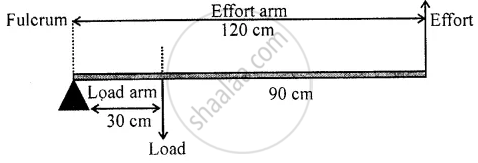Advertisements
Advertisements
प्रश्न
In a lever, the fulcrum is at one end at a distance of 30 cm from the load and effort is at the other end at a distance of 90 cm from the load. Find :
(a) the length of load arm,
(b) the length of effort arm, and
(c) the mechanical advantage of the lever.
उत्तर

Given,
(a) Load arm = 30 cm
(b) Effort arm = (90 + 30) cm = 120 cm
(c) Mechanical advantage = `"Effort arm"/"Load arm"`
= `"120 cm"/"30 cm"`
= 4
APPEARS IN
संबंधित प्रश्न
Give one example of a class I lever in a case where the mechanical advantage is equal to 1?
Give one example of a class I lever in a case where the mechanical advantage is less than 1?
Name the class to which the following levers belong:
a pair of pliers
Draw diagram to illustrate the position of fulcrum, load, and effort, of the following:
a see-saw.
State three differences between the three classes of levers.
Name the machine to which the following belong:
Sugar tongs
Answer the following in a word or two or in a sentence.
Which type of machine is used to squeeze a lemon?
Answer the following in short.
What is the basis of the classification of levers?
Explain why scissors for cutting cloth may have blades longer than the handles, but shears for cutting metals have short blades and long handles.
Draw a labelled diagram of a class II lever. Give one example of such a lever.
